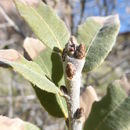en
names in breadcrumbs


Putative hybrids between Quercus arizonica and Q . grisea (= Q . × organensis Trelease) are problematic in local areas of contact from southeastern Arizona to western Texas. These intermediates tend to have narrower leaves than Q . arizonica , with moderately reticulate patterns of venation, and more densely hairy leaves. Quercus arizonica and Q . grisea are amply distinct elsewhere, including large areas in northern Mexico, and they appear to be more closely related to other species than to one another (e.g., Q . arizonica with Q . oblongifolia and Q . laeta Liebmann, and Q . grisea with Q . mohriana and Q . microphylla Née). Thus, Q . arizonica and Q . grisea are best treated as distinct species that hybridize, and not as conspecific populations.
Quercus arizonica, the Arizona white oak, is a North American tree species in the beech family. It is found in Arizona, New Mexico, western Texas, Sonora, Chihuahua, Coahuila, Sinaloa, and Durango.[4][5][6]
The Arizona white oak is one of the largest southwestern oaks. This tree may grow to 60 feet (18 meters), with a trunk diameter of 1 m (3 ft 3 in). It has stout branches and a spreading crown. The leaves are about 8 centimetres (3+1⁄4 inches) long, thick, and evergreen. It grows very slowly once it has become mature, adding approximately 0.25 cm (3⁄32 in) of diameter per year.[7]
The Arizona white oak can be found in a vast array of habitats such as savannas, grasslands, and chaparrals. They are usually found in mountain-like areas that are above about 5,495 ft (1,675 m) in elevation. Water use is low and it requires sun or part shade. Soil moisture must be dry and it must be rocky or sandy soils. Soils may be clay loam, clay, medium loam, or rocky. The Arizona white oak is both heat and cold tolerant.
When Arizona white oaks are small they usually die by fire. The acorns are usually killed by fires as well. The foliage is extremely flammable but larger trees usually survive fires that are not as severe and if a stump survives a fire it will sprout rapidly afterwards.
The wood decaying fungus Inonotus andersoni affects the Arizona white oak negatively. Burning and herbicide treatment has also affected the growth of the Arizona white oak, so they are being managed by pinyon-juniper silvicultural systems.
The wood is usually used for fuel. Since the wood of the Arizona white oak is hard, heavy, and strong, it is rarely used for commercial reasons such as furniture production.
The Arizona white oak provides cover for such animals like deer, turkeys, javelinas, desert sheep, songbirds, and quail. The white tailed deer is also known to utilize it for cover. For white-tailed and mule deer, the Arizona white oak is highly palatable as well. The only species known to consume the acorns in quantity is the thick-billed parrot.[9]
The Arizona white oak can also be used as an ornamental plant.
Quercus arizonica, the Arizona white oak, is a North American tree species in the beech family. It is found in Arizona, New Mexico, western Texas, Sonora, Chihuahua, Coahuila, Sinaloa, and Durango.